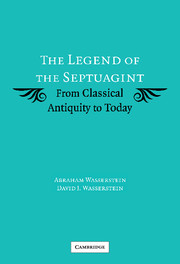Book contents
- Frontmatter
- Contents
- Preface and Acknowledgments
- Abbreviations
- Introduction
- 1 The Letter of Aristeas
- 2 The Hellenistic Jewish Tradition
- 3 The Rabbis and the Greek Bible
- 4 The Ptolemaic Changes
- 5 The Church Fathers and the Translation of the Septuagint
- 6 Among the Christians in the Orient
- 7 The Muslims and the Septuagint
- 8 Yosippon and the Story of the Seventy
- 9 Karaites, Samaritans and Rabbanite Jews in the Middle Ages
- 10 The Septuagint in the Renaissance and the Modern World
- Conclusion
- Appendix: In Partibus Infidelium: Zosimus of Panopolis
- Bibliography and Sources
- Index
Introduction
Published online by Cambridge University Press: 17 July 2009
- Frontmatter
- Contents
- Preface and Acknowledgments
- Abbreviations
- Introduction
- 1 The Letter of Aristeas
- 2 The Hellenistic Jewish Tradition
- 3 The Rabbis and the Greek Bible
- 4 The Ptolemaic Changes
- 5 The Church Fathers and the Translation of the Septuagint
- 6 Among the Christians in the Orient
- 7 The Muslims and the Septuagint
- 8 Yosippon and the Story of the Seventy
- 9 Karaites, Samaritans and Rabbanite Jews in the Middle Ages
- 10 The Septuagint in the Renaissance and the Modern World
- Conclusion
- Appendix: In Partibus Infidelium: Zosimus of Panopolis
- Bibliography and Sources
- Index
Summary
ON TRANSLATION IN THE ANCIENT WORLD
The Greek translation of the Hebrew Bible was a literary enterprise of immeasurable consequence in the history of western mankind. It has justly been called “the most important translation ever made”. It was not, however, the first translation of a text from one language into another. The practice of translation was old and well established in the Near East long before the translation of the Hebrew Bible, and translation techniques had existed for many centuries before the hellenistic age. Its products had long been known over wide areas. Such translations often served official and administrative purposes. Literary bilingualism and translation technique were also widespread in the second millennium in Mesopotamia where Sumerian texts were regularly accompanied by Akkadian translations. We know also of Babylonian interest in the grammar of the Sumerian language. A number of official translations have survived, particularly such as glorified the conquests and commemorated the achievements of imperial rulers. Among the most famous of these are the Behistun (Bisitun) inscription, on the road from Babylon to Ecbatana, of the greatest of the Achaemenid kings, Darius I (521–486 b.c.e.), in Old Persian, Elamite and Assyrian. The same ruler erected monuments inscribed on one side in Persian, Elamite and Babylonian and on the other in Egyptian hieroglyphics, along the course of the canal connecting the Nile with the Red Sea in Egypt. Such triumphal inscriptions as that at Behistun were translated into Aramaic and thus “published” throughout the empire.
- Type
- Chapter
- Information
- The Legend of the SeptuagintFrom Classical Antiquity to Today, pp. 1 - 18Publisher: Cambridge University PressPrint publication year: 2006



